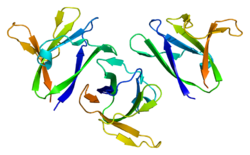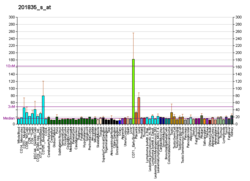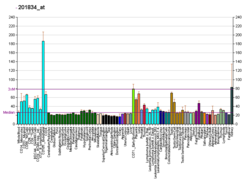PRKAB1
5'-AMP-activated protein kinase subunit beta-1 is an enzyme that in humans is encoded by the PRKAB1 gene.[5][6]
The protein encoded by this gene is a regulatory subunit of the AMP-activated protein kinase (AMPK). AMPK is a heterotrimer consisting of an alpha catalytic subunit, and non-catalytic beta and gamma subunits. AMPK is an important energy-sensing enzyme that monitors cellular energy status. In response to cellular metabolic stresses, AMPK is activated, and thus phosphorylates and inactivates acetyl-CoA carboxylase (ACC) and beta-hydroxy beta-methylglutaryl-CoA reductase (HMGCR), key enzymes involved in regulating de novo biosynthesis of fatty acid and cholesterol. This subunit may be a positive regulator of AMPK activity. The myristoylation and phosphorylation of this subunit have been shown to affect the enzyme activity and cellular localization of AMPK. This subunit may also serve as an adaptor molecule mediating the association of the AMPK complex.[6]
Interactions
PRKAB1 has been shown to interact with PRKAG2[7] and PRKAG1.[7]
The 5'-AMP-activated protein kinase beta subunit interaction domain (AMPKBI) is a conserved domain found in the beta subunit of the 5-AMP-activated protein kinase complex, and its yeast homologues Sip1 (SNF1-interacting protein 1), Sip2 (SNF1-interacting protein 2) and Gal83 (galactose metabolism 83), which are found in the SNF1 (sucrose non-fermenting) kinase complex.[8] This region is sufficient for interaction of this subunit with the kinase complex, but is not solely responsible for the interaction, and the interaction partner is not known.[9]
| AMPKBI | |||||||||
|---|---|---|---|---|---|---|---|---|---|
| Identifiers | |||||||||
| Symbol | AMPKBI | ||||||||
| Pfam | PF04739 | ||||||||
| InterPro | IPR006828 | ||||||||
| |||||||||
References
- ^ a b c GRCh38: Ensembl release 89: ENSG00000111725 – Ensembl, May 2017
- ^ a b c GRCm38: Ensembl release 89: ENSMUSG00000029513 – Ensembl, May 2017
- ^ "Human PubMed Reference:". National Center for Biotechnology Information, U.S. National Library of Medicine.
- ^ "Mouse PubMed Reference:". National Center for Biotechnology Information, U.S. National Library of Medicine.
- ^ Stapleton D, Mitchelhill KI, Gao G, Widmer J, Michell BJ, Teh T, House CM, Fernandez CS, Cox T, Witters LA, Kemp BE (February 1996). "Mammalian AMP-activated protein kinase subfamily". J Biol Chem. 271 (2): 611–4. doi:10.1074/jbc.271.2.611. PMID 8557660.
- ^ a b "Entrez Gene: PRKAB1 protein kinase, AMP-activated, beta 1 non-catalytic subunit".
- ^ a b Cheung, P C; Salt I P; Davies S P; Hardie D G; Carling D (March 2000). "Characterization of AMP-activated protein kinase gamma-subunit isoforms and their role in AMP binding". Biochem. J. 346 (3): 659–69. doi:10.1042/0264-6021:3460659. ISSN 0264-6021. PMC 1220898. PMID 10698692.
- ^ Gao G, Fernandez CS, Stapleton D, Auster AS, Widmer J, Dyck JR, Kemp BE, Witters LA (April 1996). "Non-catalytic beta- and gamma-subunit isoforms of the 5'-AMP-activated protein kinase". J. Biol. Chem. 271 (15): 8675–81. doi:10.1074/jbc.271.15.8675. PMID 8621499.
- ^ Yang X, Jiang R, Carlson M (December 1994). "A family of proteins containing a conserved domain that mediates interaction with the yeast SNF1 protein kinase complex". EMBO J. 13 (24): 5878–86. doi:10.1002/j.1460-2075.1994.tb06933.x. PMC 395563. PMID 7813428.
Further reading
- Carling D (2004). "The AMP-activated protein kinase cascade--a unifying system for energy control". Trends Biochem. Sci. 29 (1): 18–24. doi:10.1016/j.tibs.2003.11.005. PMID 14729328.
- Gao G, Fernandez CS, Stapleton D, et al. (1996). "Non-catalytic beta- and gamma-subunit isoforms of the 5'-AMP-activated protein kinase". J. Biol. Chem. 271 (15): 8675–81. doi:10.1074/jbc.271.15.8675. PMID 8621499.
- Woods A, Cheung PC, Smith FC, et al. (1996). "Characterization of AMP-activated protein kinase beta and gamma subunits. Assembly of the heterotrimeric complex in vitro". J. Biol. Chem. 271 (17): 10282–90. doi:10.1074/jbc.271.48.30517. PMID 8626596.
- Dyck JR, Gao G, Widmer J, et al. (1996). "Regulation of 5'-AMP-activated protein kinase activity by the noncatalytic beta and gamma subunits". J. Biol. Chem. 271 (30): 17798–803. doi:10.1074/jbc.271.30.17798. PMID 8663446.
- Stapleton D, Woollatt E, Mitchelhill KI, et al. (1997). "AMP-activated protein kinase isoenzyme family: subunit structure and chromosomal location". FEBS Lett. 409 (3): 452–6. doi:10.1016/S0014-5793(97)00569-3. PMID 9224708. S2CID 39329574.
- Mitchelhill KI, Michell BJ, House CM, et al. (1997). "Posttranslational modifications of the 5'-AMP-activated protein kinase beta1 subunit". J. Biol. Chem. 272 (39): 24475–9. doi:10.1074/jbc.272.39.24475. PMID 9305909.
- Thornton C, Snowden MA, Carling D (1998). "Identification of a novel AMP-activated protein kinase beta subunit isoform that is highly expressed in skeletal muscle". J. Biol. Chem. 273 (20): 12443–50. doi:10.1074/jbc.273.20.12443. PMID 9575201.
- Cheung PC, Salt IP, Davies SP, et al. (2000). "Characterization of AMP-activated protein kinase gamma-subunit isoforms and their role in AMP binding". Biochem. J. 346 (3): 659–69. doi:10.1042/0264-6021:3460659. PMC 1220898. PMID 10698692.
- da Silva Xavier G, Leclerc I, Salt IP, et al. (2000). "Role of AMP-activated protein kinase in the regulation by glucose of islet beta cell gene expression". Proc. Natl. Acad. Sci. U.S.A. 97 (8): 4023–8. Bibcode:2000PNAS...97.4023D. doi:10.1073/pnas.97.8.4023. PMC 18135. PMID 10760274.
- Strausberg RL, Feingold EA, Grouse LH, et al. (2003). "Generation and initial analysis of more than 15,000 full-length human and mouse cDNA sequences". Proc. Natl. Acad. Sci. U.S.A. 99 (26): 16899–903. Bibcode:2002PNAS...9916899M. doi:10.1073/pnas.242603899. PMC 139241. PMID 12477932.
- Lemieux K, Konrad D, Klip A, Marette A (2003). "The AMP-activated protein kinase activator AICAR does not induce GLUT4 translocation to transverse tubules but stimulates glucose uptake and p38 mitogen-activated protein kinases alpha and beta in skeletal muscle". FASEB J. 17 (12): 1658–65. doi:10.1096/fj.02-1125com. PMID 12958172. S2CID 84040744.
- Landree LE, Hanlon AL, Strong DW, et al. (2004). "C75, a fatty acid synthase inhibitor, modulates AMP-activated protein kinase to alter neuronal energy metabolism". J. Biol. Chem. 279 (5): 3817–27. doi:10.1074/jbc.M310991200. PMID 14615481.
- Inoki K, Zhu T, Guan KL (2004). "TSC2 mediates cellular energy response to control cell growth and survival". Cell. 115 (5): 577–90. doi:10.1016/S0092-8674(03)00929-2. PMID 14651849. S2CID 18173817.
- Ota T, Suzuki Y, Nishikawa T, et al. (2004). "Complete sequencing and characterization of 21,243 full-length human cDNAs". Nat. Genet. 36 (1): 40–5. doi:10.1038/ng1285. PMID 14702039.
- Andersson U, Filipsson K, Abbott CR, et al. (2004). "AMP-activated protein kinase plays a role in the control of food intake" (PDF). J. Biol. Chem. 279 (13): 12005–8. doi:10.1074/jbc.C300557200. PMID 14742438. S2CID 9226598.
- Pilon G, Dallaire P, Marette A (2004). "Inhibition of inducible nitric-oxide synthase by activators of AMP-activated protein kinase: a new mechanism of action of insulin-sensitizing drugs". J. Biol. Chem. 279 (20): 20767–74. doi:10.1074/jbc.M401390200. PMID 14985344.
- Shaw RJ, Kosmatka M, Bardeesy N, et al. (2004). "The tumor suppressor LKB1 kinase directly activates AMP-activated kinase and regulates apoptosis in response to energy stress". Proc. Natl. Acad. Sci. U.S.A. 101 (10): 3329–35. Bibcode:2004PNAS..101.3329S. doi:10.1073/pnas.0308061100. PMC 373461. PMID 14985505.
- Kim EK, Miller I, Aja S, et al. (2004). "C75, a fatty acid synthase inhibitor, reduces food intake via hypothalamic AMP-activated protein kinase". J. Biol. Chem. 279 (19): 19970–6. doi:10.1074/jbc.M402165200. PMID 15028725.
External links
- PDBe-KB provides an overview of all the structure information available in the PDB for Human 5'-AMP-activated protein kinase subunit beta-1 (PRKAB1)








